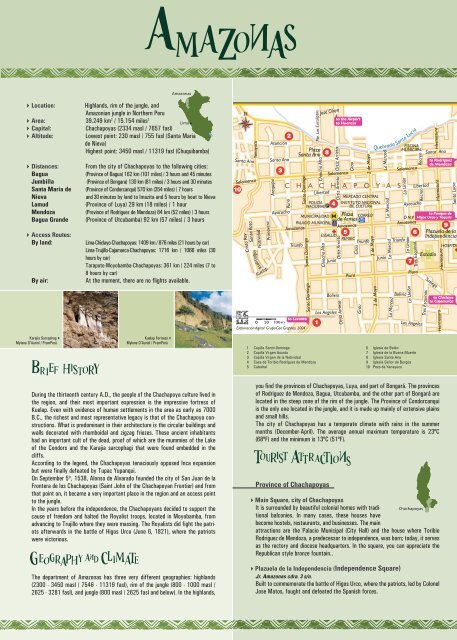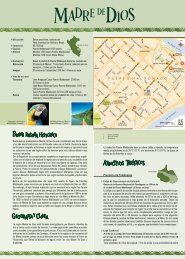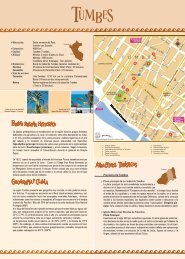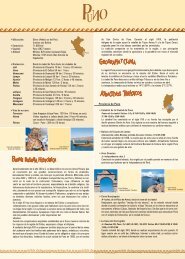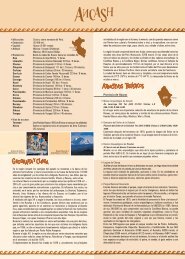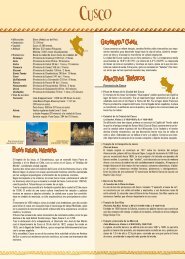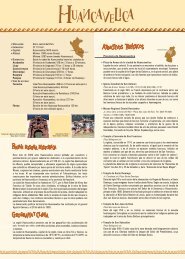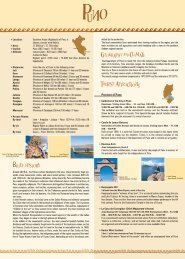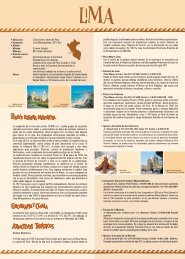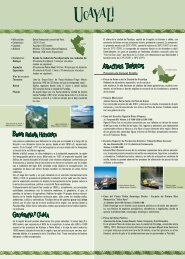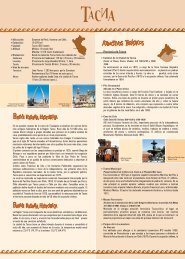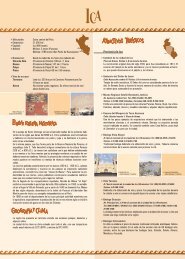Province of Chachapoyas - South American Destination
Province of Chachapoyas - South American Destination
Province of Chachapoyas - South American Destination
You also want an ePaper? Increase the reach of your titles
YUMPU automatically turns print PDFs into web optimized ePapers that Google loves.
Location:<br />
Highlands, rim <strong>of</strong> the jungle, and<br />
Amazonian jungle in Northern Peru<br />
Area: 39.249 km 2 / 15.154 miles 2<br />
Capital:<br />
Altitude:<br />
<strong>Chachapoyas</strong> (2334 masl / 7657 fasl)<br />
Lowest point: 230 masl / 755 fasl (Santa Maria<br />
de Nieva)<br />
Highest point: 3450 masl / 11319 fasl (Chuquibamba)<br />
Distances:<br />
Bagua<br />
Jumbilla<br />
Santa Maria de<br />
Nieva<br />
Lamud<br />
Mendoza<br />
Bagua Grande<br />
From the city <strong>of</strong> <strong>Chachapoyas</strong> to the following cities:<br />
(<strong>Province</strong> <strong>of</strong> Bagua) 162 km (101 miles) / 3 hours and 45 minutes<br />
(<strong>Province</strong> <strong>of</strong> Bongara) 130 km (81 miles) / 3 hours and 30 minutes<br />
(<strong>Province</strong> <strong>of</strong> Condorcanqui) 570 km (354 miles) / 7 hours<br />
and 30 minutes by land to Imazita and 5 hours by boat to Nieva<br />
(<strong>Province</strong> <strong>of</strong> Luya) 29 km (18 miles) / 1 hour<br />
(<strong>Province</strong> <strong>of</strong> Rodriguez de Mendoza) 84 km (52 miles) / 3 hours<br />
(<strong>Province</strong> <strong>of</strong> Utcubamba) 92 km (57 miles) / 3 hours<br />
Access Routes:<br />
By land:<br />
By air:<br />
Lima-Chiclayo-<strong>Chachapoyas</strong>: 1409 km / 876 miles (21 hours by car)<br />
Lima-Trujillo-Cajamarca-<strong>Chachapoyas</strong>: 1716 km / 1066 miles (30<br />
hours by car)<br />
Tarapoto-Moyobamba-<strong>Chachapoyas</strong>: 361 km / 224 miles (7 to<br />
8 hours by car)<br />
At the moment, there are no flights available.<br />
Karajia Sarcophag<br />
Mylene D'Auriol / PromPerú<br />
Kuelap Fortress<br />
Mylene D'Auriol / PromPerú<br />
1 Capilla Santo Domingo<br />
2 Capilla Virgen Asunta<br />
3 Capilla Virgen de la Natividad<br />
4 Casa de Toribio Rodríguez de Mendoza<br />
5 Catedral<br />
6 Iglesia de Belén<br />
7 Iglesia de la Buena Muerte<br />
8 Iglesia Santa Ana<br />
9 Iglesia Señor de Burgos<br />
10 Pozo de Yanayacu<br />
During the thirteenth century A.D., the people <strong>of</strong> the Chachapoya culture lived in<br />
the region, and their most important expression is the impressive fortress <strong>of</strong><br />
Kuelap. Even with evidence <strong>of</strong> human settlements in the area as early as 7000<br />
B.C., the richest and most representative legacy is that <strong>of</strong> the Chachapoya constructions.<br />
What is predominant in their architecture is the circular buildings and<br />
walls decorated with rhomboidal and zigzag friezes. These ancient inhabitants<br />
had an important cult <strong>of</strong> the dead, pro<strong>of</strong> <strong>of</strong> which are the mummies <strong>of</strong> the Lake<br />
<strong>of</strong> the Condors and the Karajia sarcophagi that were found embedded in the<br />
cliffs.<br />
According to the legend, the <strong>Chachapoyas</strong> tenaciously opposed Inca expansion<br />
but were finally defeated by Tupac Yupanqui.<br />
On September 5 th , 1538, Alonso de Alvarado founded the city <strong>of</strong> San Juan de la<br />
Frontera de los <strong>Chachapoyas</strong> (Saint John <strong>of</strong> the Chachapoyan Frontier) and from<br />
that point on, it became a very important place in the region and an access point<br />
to the jungle.<br />
In the years before the independence, the Chachapoyans decided to support the<br />
cause <strong>of</strong> freedom and halted the Royalist troops, located in Moyobamba, from<br />
advancing to Trujillo where they were massing. The Royalists did fight the patriots<br />
afterwards in the battle <strong>of</strong> Higos Urco (June 6, 1821), where the patriots<br />
were victorious.<br />
The department <strong>of</strong> Amazonas has three very different geographies: highlands<br />
(2300 - 3450 masl / 7546 - 11319 fasl), rim <strong>of</strong> the jungle (800 - 1000 masl /<br />
2625 - 3281 fasl), and jungle (800 masl / 2625 fasl and below). In the highlands,<br />
you find the provinces <strong>of</strong> <strong>Chachapoyas</strong>, Luya, and part <strong>of</strong> Bongará. The provinces<br />
<strong>of</strong> Rodriguez de Mendoza, Bagua, Utcubamba, and the other part <strong>of</strong> Bongará are<br />
located in the steep zone <strong>of</strong> the rim <strong>of</strong> the jungle. The <strong>Province</strong> <strong>of</strong> Condorcanqui<br />
is the only one located in the jungle, and it is made up mainly <strong>of</strong> extensive plains<br />
and small hills.<br />
The city <strong>of</strong> <strong>Chachapoyas</strong> has a temperate climate with rains in the summer<br />
months (December-April). The average annual maximum temperature is 23ºC<br />
(68ºF) and the minimum is 13ºC (51ºF).<br />
<strong>Province</strong> <strong>of</strong> <strong>Chachapoyas</strong><br />
Main Square, city <strong>of</strong> <strong>Chachapoyas</strong><br />
It is surrounded by beautiful colonial homes with traditional<br />
balconies. In many cases, these houses have<br />
become hostels, restaurants, and businesses. The main<br />
attractions are the Palacio Municipal (City Hall) and the house where Toribio<br />
Rodriguez de Mendoza, a predecessor to independence, was born; today, it serves<br />
as the rectory and diocese headquarters. In the square, you can appreciate the<br />
Republican style bronze fountain..<br />
Plazuela de la Independencia (Independence Square)<br />
Jr. Amazonas cdra. 3 s/n.<br />
Built to commemorate the battle <strong>of</strong> Higos Urco, where the patriots, led by Colonel<br />
Jose Matos, fought and defeated the Spanish forces.
Pozo de Yanayacu (Yanayacu Well)<br />
Located on the hill, Cerro Luya Urco, 1 km from the Main Square (15 minutes on foot)<br />
The original name <strong>of</strong> the well was “Fuente Cuyana” (Cuyana Springs) and according<br />
to tradition, single men that arrived in the city and drank its waters remained<br />
forever, attracted by the irresistible charm <strong>of</strong> its beautiful women. Saint Toribio de<br />
Mogrovejo came to this place and, on a rock, sculpted the figures <strong>of</strong> a miter and a<br />
crosier, and the year.<br />
Yalape Archeological Remains<br />
21 km / 13 miles south <strong>of</strong> <strong>Chachapoyas</strong> (40 minutes by car)<br />
Located at 2700 masl / 8858 fasl, this Chachapoya archeological complex dates<br />
back to 1100 to 1300 A.D. The area is calculated to be four hectares and features<br />
the classic circular constructions decorated with rhomboidal and zigzag friezes in<br />
high relief.<br />
Iglesia de Jalca<br />
Mylene D'Auriol / PromPerú<br />
Laguna de los Cóndores (Lake <strong>of</strong> the Condors)<br />
93 km / 58 miles south <strong>of</strong> <strong>Chachapoyas</strong> (3 hours and 30 minutes by car) is the town <strong>of</strong><br />
Leymebamba. From there, it is another 45 km / 28 miles to the lake (12 hours on foot<br />
and by mule). You will need to hire a guide.<br />
It is also known as the Laguna de las Momias (Lake <strong>of</strong> the Mummies) since more<br />
than 200 mummies were found embedded on the side <strong>of</strong> a cliff located on its<br />
shores, all in good condition despite the hot and humid climate <strong>of</strong> the area. Along<br />
with the mummies around 3000 objects belonging to the Chachapoya and Incan cultures<br />
were found. The caves are decorated with prehistoric rock paintings<br />
Leymebamba Site Museum<br />
Avenida Austria, Leymebamba. Visiting hours: Mon. – Sun. 9:30 A.M. – 4:30 P.M.<br />
The city <strong>of</strong> Leymebamba is 93 km / 58 miles south <strong>of</strong> <strong>Chachapoyas</strong> (3 hours and 30<br />
minutes by car). The museum is a 10 km / 6 miles walk from the city.<br />
This modern museum exhibits the mummies and the objects found at the Lake <strong>of</strong><br />
the Condors as well as textiles, ceramics, and weapons found in the area.<br />
<strong>Province</strong> <strong>of</strong> Bagua<br />
Numparket Waterfall<br />
40 km / 25 miles north <strong>of</strong> Bagua (3 hours by car and another 3<br />
hours by mule)<br />
This beautiful waterfall <strong>of</strong> some 90 meters / 295 feet<br />
descends into a 20 m 2 / 215 feet 2 pool..<br />
Pongo de Rentema(Rentama Narrows)<br />
Take the Jaen-Bagua highway to gain access, 14 km / 9 miles from Bagua (40 minutes)<br />
The narrows runs parallel to the Bagua-Imazita highway and is 2 km / 1,2 miles<br />
wide at its widest point. Nearby, the Marañon, Utcubamba, and Chinchipe rivers<br />
merge together.<br />
<strong>Province</strong> <strong>of</strong> Bongará<br />
Niño en fortaleza de Kuélap<br />
Mylene D'Auriol / PromPerú<br />
Laguna de Pomacochas (Lake Pomacochas)<br />
You arrive at the town <strong>of</strong> Pomacochas, 84 km / 52 miles north<br />
<strong>of</strong> <strong>Chachapoyas</strong> (3 hours by car). From there, a 1 km / 0,6 miles<br />
walk brings you to the lake (15 minutes on foot).<br />
The mere is 2858 meters / 9377 feet long, 2440 meters /<br />
8005 feet wide, and located at 2150 masl / 7054 fasl. It is fed by subterranean<br />
waters, and the color is dark green at its deepest location (80 meters / 262 feet).<br />
The surrounding flora includes totora reeds, yedra bells, and fox tails. Among the<br />
representative animals are herons and grebes.<br />
Chinata Waterfall<br />
7 km / 4 miles away from the town <strong>of</strong> Pedro Ruiz Gallo, you will arrive at the District <strong>of</strong><br />
San Carlos (20 minutes by car). From there, a 12 km / 7 miles walk takes you to the waterfall<br />
(2 hours).<br />
This waterfall is approximately 580 meters / 1903 feet, and its name means<br />
“Spring that falls from heaven”. Abundant vegetation grows all around it, typical <strong>of</strong><br />
the rim <strong>of</strong> the jungle, mostly orchids, ferns, and moss.<br />
<strong>Province</strong> <strong>of</strong> Luya<br />
Catarata y Aguas Termales de Corontachaca<br />
(Corontachaca Waterfall and Hot Springs)<br />
5 km / 3 miles from Pedro Ruiz Gallo (10 minutes by car)<br />
This is an 80 meter / 262 feet waterfall. One side has formed<br />
a small hot spring <strong>of</strong> salt and sulfuric water. Two flows <strong>of</strong><br />
heated water fall from the rocks at a rate <strong>of</strong> 2 liters per minute.<br />
Fortaleza Fortress<br />
72 km / 45 miles southeast <strong>of</strong> <strong>Chachapoyas</strong> (3 hours and 30 minutes by 4x4 vehicle)<br />
This impressive stone fortress was built by the Chachapoya people around 800<br />
A.D. It is located 3000 masl / 9843 fasl and is 6 hectares in surface. There are<br />
three defensive platforms; the first is 20 meters / 66 feet high and 680 meters /<br />
2231 feet long. Its three entrances are walled alley-ways that narrow as they climb<br />
up to the following two platforms. Inside, there are 420 circular buildin.<br />
Karajia Sarcophagi<br />
48 km / 30 miles northeast <strong>of</strong> <strong>Chachapoyas</strong> (2 hours by car and another 20 minutes on<br />
foot)<br />
These c<strong>of</strong>fins are pre-Inca tombs, some 1000 years old, implanted at the top <strong>of</strong> a<br />
cliff. They are 2 meters / 7 feet tall, sculpted in mud, and are decorated with geometric<br />
motives. They probably served to house the remains <strong>of</strong> the supreme tribal<br />
leaders.<br />
The most important dances <strong>of</strong> the department are the Chumaichada (an urban<br />
dance), the Levanto dance, the Anchashkenken, the Trenzas, the Chuquiac, the<br />
Carnaval de <strong>Chachapoyas</strong> dance, and the El Brazo dance.<br />
The following list highlights some typical dishes <strong>of</strong> Amazonas:<br />
Purtumute: Boiled beans with mote sancochado (individual grains <strong>of</strong> corn boiled<br />
with cilantro)<br />
Cuy con papas: Seasoned, cooked, and fried Guinea pig served with a potato stew,<br />
toasted peanuts, chopped onions and hot peppers.<br />
Juanes de yuca: Grated and boiled yucca mixed with rice and either chicken or<br />
beef jerky; this mixture is wrapped in a banana leaf and steamed.<br />
Cecina: Beef or pork jerky<br />
Tamales: Mashed corn filled with beef, wrapped in banana leaves, and steamed.<br />
Humitas: Mashed corn filled with seasoned beef or cheese, wrapped in corn<br />
shucks and steamed.<br />
Enrollado: Roast beef, rolled and stuffed with ground pork and chicken meat,<br />
raisins, and hard boiled egg.<br />
Traditional drinks<br />
Guarapo: drink made from boiled and fermented sugar cane juice.<br />
Chuchuhuasi: cordial made from a bitter root <strong>of</strong> the same name; very popular<br />
everywhere in eastern Peru but found only in the <strong>Province</strong> <strong>of</strong> Condorcanqui.<br />
Licor de mora: made from cordial, blackberries, and syrup.<br />
Licor de leche: made from cordial and whey filtered drop by drop until transparent.<br />
Pur Pur: made from cordial, fruit and pur pur seeds. Later, syrup is added.<br />
Chachapoyan Carnival – February – March<br />
<strong>Province</strong> <strong>of</strong> <strong>Chachapoyas</strong><br />
It is a mixture <strong>of</strong> Celendinas and Chachapoyan customs. It is celebrated with the<br />
planting <strong>of</strong> “Humishas”, large trees decorated with balloons, streamers, clothing,<br />
and other objects. In addition, there is a float contest, a carnival queen election,<br />
social and popular dancing, and games with water, streamers, and colors
<strong>Chachapoyas</strong>’ Tourist Week – June 1 st – 7 th<br />
<strong>Province</strong> <strong>of</strong> <strong>Chachapoyas</strong><br />
Filled with recreational, social, and cultural activities, the highlight <strong>of</strong> this event is<br />
“el Raymillacta de los <strong>Chachapoyas</strong>”, which gathers dancers from all the regional<br />
communities to demonstrate the best <strong>of</strong> their traditional dances.<br />
Feast <strong>of</strong> Saint Mary <strong>of</strong> the Assumption– August 7 th – 15 th<br />
<strong>Province</strong> <strong>of</strong> <strong>Chachapoyas</strong><br />
The image <strong>of</strong> the Virgin is carried through the city streets <strong>of</strong> <strong>Chachapoyas</strong>, which<br />
are covered with multicolored carpets <strong>of</strong> flowers. Many cultural activities, artisanal<br />
and agricultural fairs, dances, typical food tasting, and Peruvian Paso horse presentations<br />
take place.<br />
Festival <strong>of</strong> Saint Nicolas de Tolentina and the Virgin <strong>of</strong> the<br />
Nativity – September 7 th – 12 th<br />
<strong>Province</strong> <strong>of</strong> Rodríguez de Mendoza<br />
This is a festival <strong>of</strong> traditional customs in which everyone participates. Gastronomical and<br />
agricultural fairs and recreational and tourist activities take place.<br />
Festival <strong>of</strong> the Lord <strong>of</strong> Gualamita – September 10 th – 16 th<br />
<strong>Province</strong> <strong>of</strong> Luya, District <strong>of</strong> Lamud<br />
On September 13 th , the Hatun Luya is celebrated, where everyone from the surrounding areas<br />
comes together. During this festivity, you can witness demonstrations <strong>of</strong> popular customs.<br />
Throughout the entire festival, there is music and dances from around the deapartment.<br />
OVERLAND TRANSPORT<br />
<strong>Chachapoyas</strong>: There is no bus station; however, most <strong>of</strong> the businesses are located<br />
on 3 rd and 4 th blocks <strong>of</strong> Jiron Ortiz Arrieta, 9 th block <strong>of</strong> Jiron Salamanca, 3 rd block<br />
<strong>of</strong> Jiron Grau, and 4 th block <strong>of</strong> Jiron Libertad.<br />
HEALTH CENTERS<br />
<strong>Chachapoyas</strong>.<br />
Hospital General Base <strong>Chachapoyas</strong> (<strong>Chachapoyas</strong> General Hospital)<br />
Jiron Triunfo, block 3 Telephone: (041) 47-7016 / 47-7792. Attention: 24 hours<br />
Higos Urco Hospital (ESSALUD – Ministry <strong>of</strong> Health)<br />
Intersection <strong>of</strong> Jiron Ortiz Arrieta and Jiron Amazonas<br />
Telephone: (041) 47-7052 / 47-8086. Attention: 24 hours<br />
Bagua: Bagua Apoyo Hospital<br />
Avenida Principal 980 Telephone: (041) 47-1159 / 47-2064. Attention: 24 hours<br />
LOCAL POLICE<br />
<strong>Chachapoyas</strong>: Jiron Amazonas 1220, <strong>Chachapoyas</strong>. Telephone: (041) 47-7017.<br />
Attention: 24 hours<br />
Bagua: Avenida Heroes del Cenepa 1700. Telephone: (041) 47-1416.<br />
Attention: 24 hours<br />
Bagua Grande: Avenida <strong>Chachapoyas</strong> 2318. Telephone (041) 47-4403.<br />
Attention: 24 hours<br />
CRAFT MARKETS<br />
<strong>Chachapoyas</strong>:<br />
The handicraft shops are found on the 7 th block <strong>of</strong> Jiron Ortiz Arrieta, 8 th and 9 th<br />
blocks <strong>of</strong> Jiron Amazonas, and 7 th block <strong>of</strong> Jiron 2 de Mayo.<br />
POSTAL SERVICES<br />
<strong>Chachapoyas</strong>: Serpost<br />
Jiron Ortiz Arrieta 632, <strong>Chachapoyas</strong>. Telephone: (041) 47-7019.<br />
Attention: Mon.-Sat. 8:00 A.M.-8:00 P.M.<br />
Bagua Grande: Jiron San Martín 350 Telephone (041) 47-4505.<br />
Attention: Mon.-Sat. 8:00 A.M.-4:00 P.M..<br />
NATIONAL TOURISM CHAMBER www.canaturperu.org<br />
REGIONAL GOVERNMENT OF AMAZONAS www.regionamazonas.gob.pe<br />
Association <strong>of</strong> Hotels, restaurants, and Related Services – AHORA<br />
<strong>Chachapoyas</strong> www.chachapoyasperu.com.pe<br />
TOURIST INFORMATION<br />
At the Tourist Information and Assistance Service, iperu, you can ask for objective<br />
and impartial tourism information, as well as assistance in case the tourist services<br />
you received were not provided according to the contract signed.<br />
Contact the service nationwide, 24 hours a day:<br />
Telephone: (01) 574-8000 Email: iperu@promperu.gob.pe<br />
<strong>Chachapoyas</strong>: Jiron Ortiz Arrieta 588, Plaza de Armas (Main Square)<br />
Telephone: (041) 47-7292 Attention: Mon. – Sat. 8:00 A.M. – 7:00 P.M.<br />
Email: iperuchachapoyas@promperu.gob.pe<br />
MORE INFORMATION: www.peru.info<br />
Legal Deposit Number: 2005-7543<br />
The information contained in this document is a list <strong>of</strong> attractions and services at the disposal <strong>of</strong> the traveler<br />
in the entire department. In order to update it, PromPeru has been assisted by <strong>of</strong>ficial information<br />
sources like: National Institute for Natural Resources (INRENA), National Culture Institute (INC), National<br />
Institute <strong>of</strong> Geography (IGN), National Meteorology and Hydrology Service (SENAMHI), and the Regional<br />
Administration <strong>of</strong> Foreign Trade and Tourism.<br />
Commission for the Promotion <strong>of</strong> Peru


